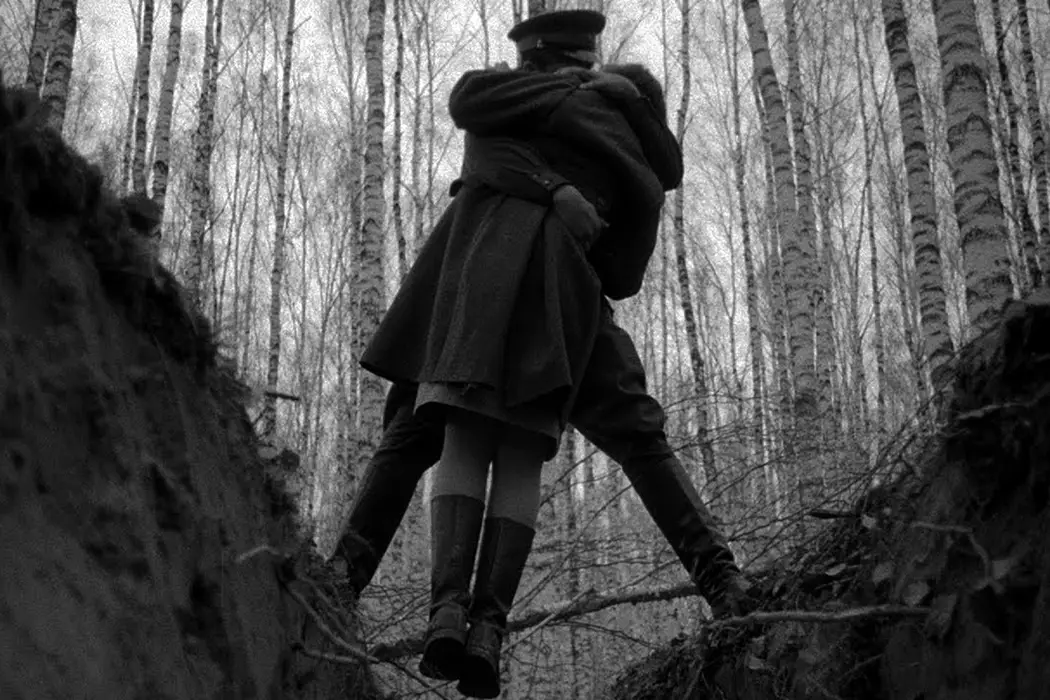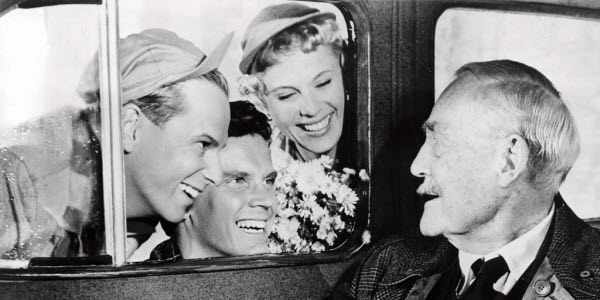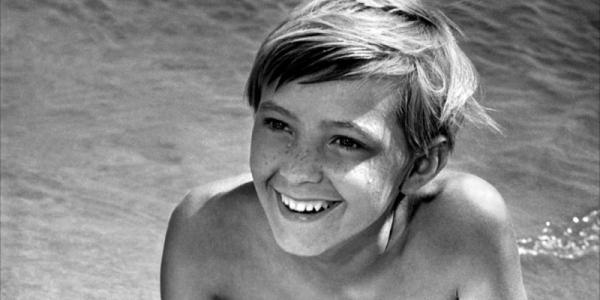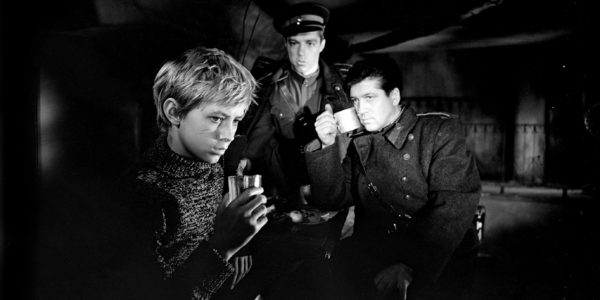IVAN’S CHILDHOOD & The Horror Of Waking Up

Jack is a recent MA Graduate from the film department…
Among the most fascinating elements of cinema, from the writing process to the visual design, is the way in which the medium handles the tricky and often overwhelming idea of dreams. Dreams are so difficult to visualise for the same reason that they are so confusing to recount after we wake up; a dream can change the colours of your world, of your emotions, in way that feels personal but may be in fact, anything but.
Sigmund Freud was interested in dreams, and the way that visual media portrayed them in a manner that was perhaps too analytical – in his book Films and Dreams, Thorsten Botz-Bornstein details how Freud was primarily concerned with the way that dreams, and the visual representation of them, provided ‘essential facts concerning the development of neuroses, mental diseases and other phenomena diverging from “normal” modern life.’
In a modern cinematic depiction of dreams, are the creators of said presentations, or the characters that lie within them, concerned with the same ideas that Freud was? It would obviously depend on each visualisation, and the motivations of those who are creating the illusion – if anything, Freud‘s interests in what we can discover from dreams is almost too limited for what cinema hopes to discover about the characters, the creators and the audience through visualising the unconscious.
Cinema as a medium is so often compared to dreams in the broadest sense: films leap from one place to another at will, the art of editing creates an effect which is not too dissimilar to the fragmented nature of dreams. As Robert Curry says in The Journal of Aesthetics and Art Criticism, dreams are undoubtedly more cinematic then our real-life experiences, and in a paradoxical way, that may be emphasised by our own film-watching habits.
Lynch and Bergman – Bookending the Dream
No wonder, then, that certain films work so beautifully as extended dream-sequences; David Lynch‘s Mulholland Drive, voted as the best film of the 21st century in a BBC Culture poll, works as astonishingly as it does because there is something intrinsically unconscious about the way its narrative drifts, about the way that seemingly disconnected scenes just happen in spite of each other, how absurd characters enter the narrative and yet their absurdity remains frightening, their seriousness disjointing.

Years before Lynch, Ingmar Bergman created Persona, the unflinchingly nasty, hallucinatory thriller that may be cinema’s most classically acclaimed nightmare; however, it is Bergman’s Wild Strawberries, the melancholic, searingly emotional drama of an old man’s journey to accept death that is framed by two dream sequences, both of which contradict each other and shape the images that follow and precede them. The opening sequence is a genuinely scary meditation on the fear of death – our protagonist, surrounded by indications of time, always slipping away, sees a coffin fall off a horse-drawn carriage and his own body appear out of it. For the themes that the movie explores, this dream sequence is the most ambitiously suitable and aesthetically appropriate way to visualise what our protagonist fears, and it helps the rest of the film follow a similar trajectory of fear and self-doubt.
It is the final dream sequence, however, with that unforgettable image of our protagonist looking across the river to see his parents at peace at their old family home, that is the dominating visual of the picture. Dreams conjoin the themes of dread and hope in Wild Strawberries; they shape the film for us and give swells of joy and fear that echo throughout the rest of the film’s more grounded elements.
Ivan’s Childhood: Shaping the Visual, Portraying the Dream
The main focus of this article, however, is unlike both of these previous examples of Mulholland Drive and Wild Strawberries. Andrei Tarkovsky‘s first major work, Ivan’s Childhood, is a film that is personal to me because it fundamentally changed the way in which I viewed the potential of the moving image. In the same way that Kate Bush’s The Kick Inside changed my perception of music, after experiencing Ivan’s Childhood I suddenly viewed everything else presented to me in the medium a different way – as if, with clearer eyes, other attempts seemed duller.
The story of a young boy recruited as a spy at the tail end of the second world war, it takes us literally through, as suggested, his childhood; a warped coming-of-age tale centred around a remarkably brave child who knows nothing else but the fight and the deaths that come with it. Ivan is perhaps the most mature character in the film, his mentors and adult colleagues squabbling over money, women, things that Ivan has an almost unwitting wisdom about when faced with their unimportance.
It is through the nature of the dream that Tarkovsky shows us the childhood of Ivan, or, perhaps, so the audience would like to believe. Maybe the horror of the film is that these childhood memories that Ivan dreams of did not happen, that they are the memories of childhood he could have had, visions of innocence and irresponsibility that he wishes could have shaped him, prevented him from becoming what he is. We see rolling fields in these dreams, the unforgettable image of Ivan peering through the spider’s web, his mother; does Ivan even remember what his mother looked like? An unanswerable question totally because it is through our own curiosity, perhaps our own fear, that we question the validity of these dreams, their reliability as memories instead of yearning visions.

It is through the opening of the film that, just like with Wild Strawberries, the tone of the movie is shaped, through the juxtaposition of its bliss and its horror, through its surrealism and strangeness. Its simultaneous manner of flowing like water and snapping like fingers makes it an extraordinary two minutes of cinema, where Tarkovsky sends us into the dream and rudely, horrifyingly, wakes us up to begin the story.
It is not at all an exaggeration to say that the first image of the film immediately reminds us of a dream – there is no establishing shot of country roads and the hills of a valley, nor is there a steady introduction to Ivan as a visual presence. It is an arresting opening because it immediately begins, it snaps the story into life immediately through that iconic image of Ivan looking through the cobweb, an unusual example of being asked to take in an already established image as the very first aesthetic of the film. Tarkovsky then allows the camera to float upwards and get a sense of the surrounding area, with Ivan diminished to a smaller figure on the landscape’s palette: it would almost make more cinematic sense to play these first few seconds in reverse, but for the world of the dream, for Ivan’s dream, it makes perfect sense.
What might appear to be sloppy, unfocused editing is considered appropriate in the world of the dream – as already mentioned, film does lend itself to the world of the dream almost naturally through simple editing, but here Tarkovsky exaggerates its guttering style, its bizarre and sweeping changes to image and to tone. Straight after this luscious wide shot of the area around Ivan the audience is given a close-up shot of a goat, a transition so sudden it inevitably ends up being frightening. Perhaps the goat is the first indication by Tarkovsky that something is wrong with not only this dream but with reality, or perhaps it is a simple reminder that dreams do not follow the rules of cinema; traditional means of editing need not apply when dealing with the subconscious.
Diving into Surrealism and an Imaginary Childhood
As Ivan begins to run further into the dream, the illusions stack up. His gazing at a butterfly results in him floating up in the air – a visual that for me, undoubtedly inspired Isao Takahata’s beautiful imagery of Taeko flying in Only Yesterday. Although this is a moment of surrealism, a detachment from the cold reality that will follow, it is perhaps the moment of childhood joy in the film, a sweeping, beautiful sequence of freedom that lifts Ivan up and brings him back down with nary a bump.
Earlier in this article I said that this film ‘fundamentally changed the way in which I viewed the potential of the moving image’ and here comes perhaps the most clearest example of that power; the transition shot from Ivan’s point-of-view descent to earth into a horizontal pan across a wall of rock and twigs is simply astonishing, a marvellously fluid moment of imagination from Tarkovsky that totally takes the breath away. It is at once both completely jarring and totally natural – the images blend together perfectly but it is the change of direction for the camera from left to right that subsequently gives the tone of the transition an air of something; menace, fear? What a feeling of the dream this captures, where images appear so naturally but with such a simultaneous jolt; it is a paradox of image composition and it works superbly here.
One of the most extraordinary, and rather frightening, aspects of a dream is for the passion of the experience, the vividness of the content and the feeling of it, to convince you that everything you just experienced really happened. It is this feeling, a potentially devastating, literal wake-up call that Tarkovsky captures so effectively here. What is so powerful about this sequence is not the imagery within it, however powerful that may be, but the juxtaposition of the dream and the reality.
There are more images to explore, more feelings to uncover; what is Tarkovsky trying to express when showing the beam of light that comes through the trees? It is a spiritual moment in a film that, with its jagged edges and frightening realities, is a rejection of the holy and an acceptance of the dour. The appearance of Ivan’s mother is an image repeated in the final sequence of the film, her standing with her bucket of water that Ivan so thankfully drinks from.
Her normality is striking; this must be the final image that Ivan remembers of her, water in hand and welcoming smile as clear as the sunshine. She is soon to be shattered by reality, Takovsky’s camera suddenly and violently focusing in on her face, twisting to an obtuse angle, an angle that almost in itself wakes Ivan from his dream.
Waking up Ivan – Waking up the Audience
This is where the dream’s power lies – the sudden visual of Ivan waking in a dark, ruined structure to the sounds of war is a truly arresting contrast for the audience to take in. We knew we were in the dream, it would have been naive for us to believe we weren’t, but to wake up to this, the horror of a child in war, sets a mood of tragedy that envelops the rest of the film. This is that feeling of snapping awake that can be so damaging – we, the audience, are now left to wonder what of that dream actually happened and what was simply Ivan’s desperate imagination.

The dream represents the freedom of childhood, the freedom to be able to make irresponsible choices and to be happy, happy in ignorance. Was Ivan ever given this freedom; is that his mother that we saw, or what he believes his mother looked like? It is a truly unique ability of the dream to make us long for the reality that was so fleetingly presented to us; in Ivan’s Childhood, Tarkovsky gives us that same feeling, that same dream, but for someone other than ourselves.
In the film’s final dream sequence, Ivan runs over beaches, dances on water, grasps at air. His final movement and the final moment of the film is him stumbling, desperately lunging to grab…what? The film has taken Ivan’s future and now he grasps at where it used to be, stumbles in the face of the loss of himself. At the end of the film, end of the dream, we are left with more questions than answers – in Ivan’s Childhood, Tarkovsky shows us images tinged with the individual hazes and feelings of that indescribable visual landscape, the dream, and cruelly takes them away from us.
What other movies do you associate with the dream? What films changed your way of viewing cinema? Please let us know in the comments!
Does content like this matter to you?
Become a Member and support film journalism. Unlock access to all of Film Inquiry`s great articles. Join a community of like-minded readers who are passionate about cinema - get access to our private members Network, give back to independent filmmakers, and more.
Jack is a recent MA Graduate from the film department at the University of Southampton. He has been writing about film and football casually since 2013, considering himself as an expert on the works of Akira Kurosawa, Park Chan-wook and Steve McQueen ; less of an expert on every other important director.













